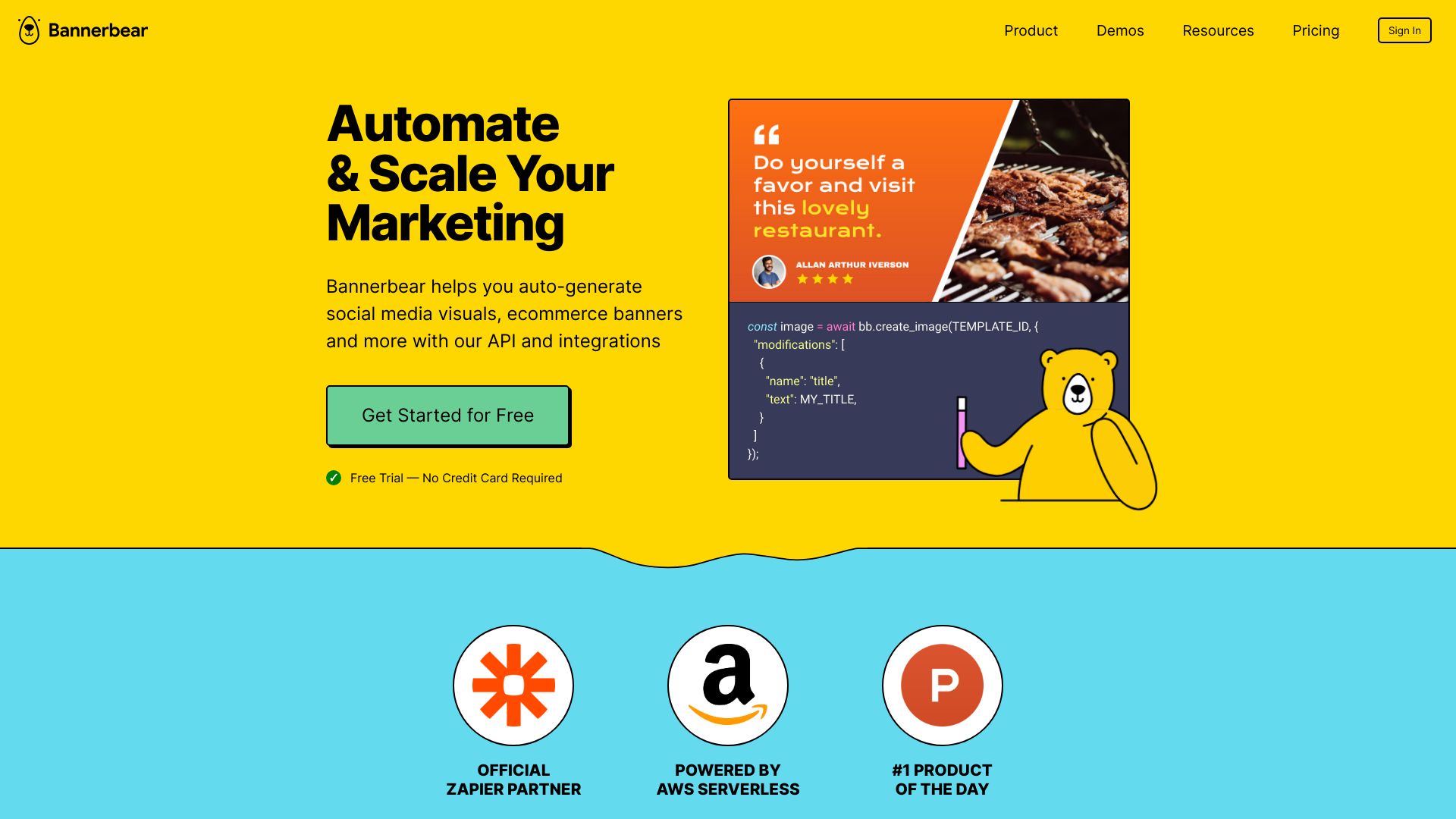- Home
- AI Image Generator
- Bannerbear

Bannerbear
Open Website-
Tool Introduction:Generate social visuals, banners, and videos via API automation at scale.
-
Inclusion Date:Oct 28, 2025
-
Social Media & Email:
Tool Information
What is Bannerbear AI
Bannerbear AI is an API-first media generation platform for automating on-brand visuals at scale. It converts design templates into programmable endpoints, so teams can create large sets of variations for social posts, e-commerce banners, podcast videos, and PDFs without manual editing. With image, multi-image, video, and PDF generation APIs plus no-code integrations for Zapier, Airtable, Make.com, form tools, and WordPress, it streamlines repetitive marketing tasks. Map data into template fields, trigger renders from your stack, and deliver consistent assets faster while maintaining brand standards.
Bannerbear AI Main Features
- Template-to-API workflow: Turn graphic templates into programmable endpoints to generate endless variations from structured data.
- Multi-format output: Create images, multi-image carousels, videos, and PDFs with a single tool to cover social, ads, and documentation use cases.
- No-code automation: Build end-to-end flows via Zapier, Airtable, Make.com, forms, and WordPress to eliminate repetitive design work.
- Data-driven rendering: Populate text, images, and colors from spreadsheets, databases, or forms for consistent brand-ready assets.
- Batch and on-demand generation: Produce assets individually or in bulk, triggered by events or schedules.
- Brand consistency: Lock layouts and components so every output follows your typography, colors, and spacing rules.
- Team-friendly operations: Centralize templates and automate distribution across channels and campaigns.
Who Should Use Bannerbear AI
Bannerbear AI suits marketing teams, e-commerce operators, social media managers, content operations, agencies, podcasters, and no-code builders who need scalable, repeatable asset creation. It is also useful for product and engineering teams integrating image and video generation APIs into apps or workflows.
How to Use Bannerbear AI
- Create or import a design template with the layers and fields you want to control (texts, images, colors).
- Define variable fields and naming so they can be filled programmatically.
- Choose your integration path: direct API calls or no-code tools like Zapier, Airtable, Make.com, forms, or WordPress.
- Map data sources to template fields (e.g., product titles, prices, headshots, episode names).
- Trigger a test render to validate layout, typography, and asset quality.
- Automate at scale by running batches or connecting triggers (new row, form submission, schedule).
- Retrieve generated assets for distribution to social channels, e-commerce listings, or CMS.
Bannerbear AI Industry Use Cases
E-commerce teams auto-generate product banners with prices, discounts, and backgrounds for new SKUs sourced from Airtable. Social teams produce weekly campaign visuals and multi-image carousels from spreadsheets. Podcasts generate branded episode videos for feeds and websites. Agencies deliver localized ad sets across markets using template variables for language, imagery, and color themes. Publishers export PDFs for announcements and changelogs directly from structured content.
Bannerbear AI Pricing
Bannerbear AI typically follows a tiered, subscription-based model that scales by usage (such as render volume) and features. A free trial is commonly available so teams can test templates, APIs, and no-code integrations before committing to a paid plan.
Bannerbear AI Pros and Cons
Pros:
- API-first design enables reliable automation across apps and workflows.
- Supports images, multi-image sets, videos, and PDFs from a single system.
- No-code integrations reduce engineering effort for marketing operations.
- Template-driven approach maintains brand consistency at scale.
- Efficient for bulk and recurring campaigns driven by structured data.
Cons:
- Creative flexibility is bounded by the template; complex custom layouts may need redesign.
- High-volume rendering can require careful credit and cost planning.
- Video generation may take longer than static images in busy workflows.
- Initial setup requires thoughtful field mapping to prevent layout overflow or truncation.
Bannerbear AI FAQs
-
Do I need to code to use Bannerbear AI?
No. You can automate with Zapier, Airtable, Make.com, forms, or WordPress. Developers can use the REST-style APIs for deeper integration.
-
How do templates work?
You define a design once, mark fields as variables, then pass data to generate variations without manual editing.
-
What formats can I generate?
Bannerbear AI supports image, multi-image, video, and PDF generation, suitable for social posts, ads, listings, and documentation.
-
Can I run bulk renders?
Yes. You can batch-generate assets from spreadsheets or databases and trigger renders on schedules or events.
-
How does it integrate with existing tools?
Use prebuilt integrations for Zapier, Airtable, Make.com, forms, and WordPress, or connect directly via API from your app or backend.

